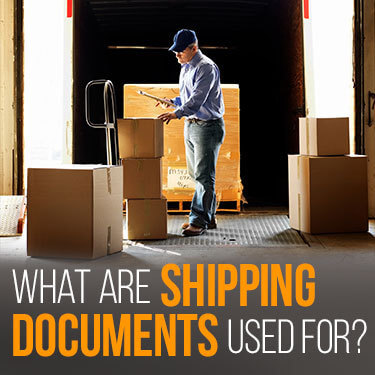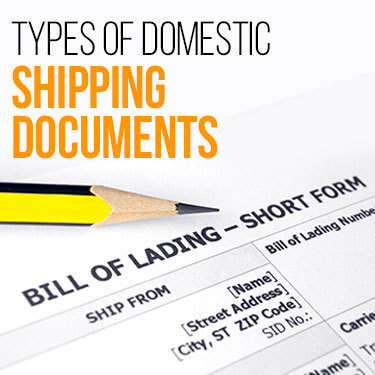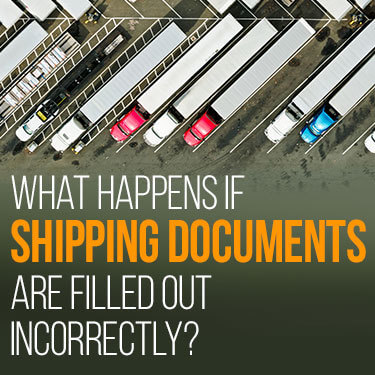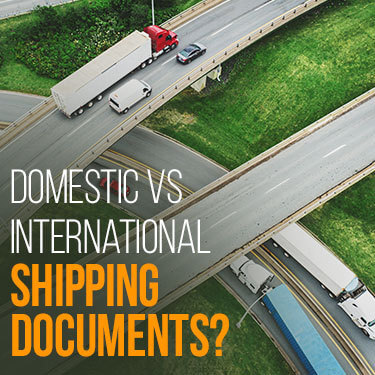Having the correct documents required for domestic shipping is vital to getting your freight to its destination promptly. Unfortunately, shippers constantly forget to fill out the important documents that accompany their domestic freight shipments. In some cases, shippers don’t know which documents they should use.
The Department of Transportation (DOT) requires various documents for domestic shipping.
These documents communicate detailed information about your shipment that’s used by the carrier, receiver and sometimes, the local and federal government.
Each one of the documents required for domestic shipping is unique and must be completed with care. We’ll give you the details on each so you can avoid making potential mistakes.

Shipping documents are more than just pieces of paper for you to write on. They help convey important information that carriers need to transport your goods. Depending on the goods your shipping has regulations attached to them, you might need to include documentation indicating that you comply with those regulations. The receiver of your goods also uses shipping documents for their needs.
Shipping documents for hazardous freight must be kept for record-keeping purposes. As per Title 49 of the Code of Federal Regulations part 172.201, documents for hazardous waste shipments must be kept for three years following the date they were accepted by the carrier. Normal hazardous shipments only need to be kept two years after the carrier accepted them.
Some examples of hazardous shipments include:
Hazmat documents are kept because federal, state and local governments can request to see them at any time to research or inspect information regarding your hazardous shipments. Therefore, it’s important to make sure to keep copies of any paperwork about a hazmat shipment.
There are quite a few different regulations placed on domestic shipments that the DOT enforces. Many of these regulations apply only to carriers, but for them to comply with these regulations, you must do your part to fill out your paperwork correctly.
While we’ve already discussed some of the hazmat regulations that apply to carriers, there are plenty of other rules they’re held to such as the weight of their shipment.
Other aspects of transportation that DOT has rules for include:
Without properly filled out paperwork, carriers can’t certify that they’ve complied with regulations expected of them. This can cause numerous problems for your shipment.
Your shipping documents contain important information about your freight. The carrier uses this information to determine how to handle your shipment. This includes how it’s loaded and what actions must be taken should an accident occur.
While carriers do their best to take care of your freight, certain types need special treatment. Shipping documents help indicate these needs.
Carriers need to know where they’re going and they can’t do that without an address of the delivery point. Not only that, but they need to be able to deliver that freight in the time prescribed to them. Without information on shipping documents to indicate this, your freight can’t get to where it needs to go at the time you need it. .
At R+L Global Logistics, we can guarantee you that our deliveries will be completed for you fast and efficiently.

Fortunately, there aren’t too many documents you will have to fill out for domestic ground shipments. Most of these documents are fairly easy to fill in since they request basic information about your freight that you should already know. In some cases, certain documentation can even be left out depending on the type of freight you’re trying to ship.
The BOL is the most common type of document used in both domestic and international shipments. Regardless of which type of shipment you’re making, the information that the BOL asks for will be the same.
This information includes some of the following:
Another field in the BOL that needs to be filled out is the packaging type that will be holding your freight. This can include the following options:
If you want to include specific instructions to the carrier or a special tracking number, the BOL is where you’ll include this information at. The BOL also has a field where you will cite hazardous material information about your freight. This field is left blank if hazardous materials are not part of your shipment.
Lastly, there are multiple types of bills of lading you should be familiar with.
The ocean BOL is used for international shipments, so you won’t have to worry about filling one out when you need to move freight domestically. Our article on the 8 bills of lading will give you more information about these documents and all of their varieties.
Freight bills and BOLs are fairly similar to one another. They both require that the same information be included in them. That said, the freight bill differs because the information that it provides about the freight is explained in more detail.
Think of the BOL as a summary of your shipment and the freight bill as the essay for it. Additionally, the freight bill provides information about the shipment's consolidated cost. Lastly, the freight bill is not a legally binding agreement like the BOL is.
Both the freight bill and the BOL are used in conjunction with one another, so you must fill out both documents with extreme accuracy.
Packing lists are more often encouraged for international shipments, but they’re commonly used for domestic shipments as well. Packing lists contain information that pertains specifically to the items you’re shipping.
The information included in this document includes:
The packing list can be included in the box holding the items or on a palletized shipment, outside of one of the boxes in a clear plastic envelope attached to the box. The packing list is provided specifically for the receiver. With the packing list, the receiver can determine if any goods have been damaged and if any goods are missing from the box.
Packing lists provide great customer service, which is one of the many logistical challenges that receivers face. Therefore, you should make sure that your packing list is always accurate.
The POD is a document that is signed by the receiver of the goods. By signing the document, the receiver is confirming that they now have possession of the goods and that the goods are in acceptable condition. Carriers provide this document in either paper form or by email.
Regardless of which form the POD comes in, you should ask for a copy for your own recordkeeping. Having this document ready will be useful in case the receiver causes a dispute regarding the well-being of the goods when they took ownership of them.
Hazardous materials are dangerous and when spilled, they can be harmful to anyone exposed to them. Therefore, there are arduous amounts of regulations enforced by the DOT that shippers and carriers alike must follow.
When transporting hazardous materials, your hazmat shipping papers must include the following information:
Paperwork for hazmat shipments doesn’t have to follow a specific format. However, it does need to be recorded on paper in a cohesive sequence. That said, the information on the hazmat goods must be to the specifications of hazardous materials regulations specified by the DOT.
A record of HAZMAT-related injuries shows exactly why these shipments have so many different regulations that accompany them.
| Year | HAZMAT Related Injuries |
| 2017 | 155 |
| 2018 | 148 |
| 2019 | 182 |
| 2020 | 131 |
| 2021 | 25 |
Provided by DOTs Bureau of Transportation Statistics

There are a variety of different problems that could arise if you don’t fill out all of your shipping documents correctly. Some of the common mistakes that shippers make and the corresponding repercussions include:
Any mistake that’s made with regards to shipping documents will always cost you time and unnecessary stress. In some cases, it could even cost you money. The best way to avoid these mistakes is by getting yourself some help.

Domestic and international shipments both need to have proper documentation accompanying them. Fortunately, domestic and international shipments share all of the documents we’ve already listed.
There are some additional documents that you will need to include when dealing with an international shipment of freight.
Another distinction between domestic and international shipping documents are the federal agencies involved. Customs and Border Protection (CBP) is the agency that oversees all imports and exports.
The CBP also has strict requirements regarding certain shipping documents. Depending on the goods you import, you might need to satisfy the regulations of another federal agency. That means obtaining any additional shipping documents they require.
USA Truckload serves as the middleman between you and your carrier. By partnering with carriers all across the country, we’re able to provide our customers with the various shipping services they need to get their goods moved.
We provide services for:
We also provide our customers with consulting services. During a consulting session, you can ask questions about your shipment and learn important information regarding your freight shipment.
While we strive to handle your shipments with care, any number of things could happen to your freight once it’s traveling in the back of a trailer. That’s USA Truckload also provides freight insurance that will protect your goods should anything ever happen to them.
At USA Truckload, we go the extra mile for our customers. Fill out your quote today or give us a call at 886-353-7178 to inquire about our consulting and freight insurance.
R+L Global Logistics
315 NE 14th St., Ocala, FL 34470